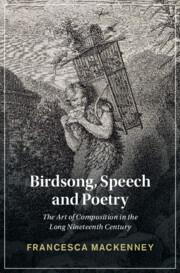Refine search
Actions for selected content:
10298 results in History of science: general interest
Chapter 5 - ‘We Teach ’Em Airs That Way’
-
- Book:
- Birdsong, Speech and Poetry
- Published online:
- 15 September 2022
- Print publication:
- 22 September 2022, pp 137-179
-
- Chapter
- Export citation
Bibliography
-
- Book:
- Birdsong, Speech and Poetry
- Published online:
- 15 September 2022
- Print publication:
- 22 September 2022, pp 217-232
-
- Chapter
- Export citation
Introduction
-
- Book:
- Birdsong, Speech and Poetry
- Published online:
- 15 September 2022
- Print publication:
- 22 September 2022, pp 1-19
-
- Chapter
- Export citation
Conclusion
-
- Book:
- Birdsong, Speech and Poetry
- Published online:
- 15 September 2022
- Print publication:
- 22 September 2022, pp 180-184
-
- Chapter
- Export citation
Copyright page
-
- Book:
- Birdsong, Speech and Poetry
- Published online:
- 15 September 2022
- Print publication:
- 22 September 2022, pp iv-iv
-
- Chapter
- Export citation
Chapter 3 - ‘Prelusive Notes’
-
- Book:
- Birdsong, Speech and Poetry
- Published online:
- 15 September 2022
- Print publication:
- 22 September 2022, pp 60-100
-
- Chapter
- Export citation
Chapter 1 - The Science of Birdsong
-
- Book:
- Birdsong, Speech and Poetry
- Published online:
- 15 September 2022
- Print publication:
- 22 September 2022, pp 20-37
-
- Chapter
- Export citation

Birdsong, Speech and Poetry
- The Art of Composition in the Long Nineteenth Century
-
- Published online:
- 15 September 2022
- Print publication:
- 22 September 2022
Suggestions for Further Reading
-
- Book:
- A Narrative of Cultural Encounter in Southern China
- Published by:
- Anthem Press
- Published online:
- 10 January 2023
- Print publication:
- 13 September 2022, pp 89-90
-
- Chapter
- Export citation
1 - Introduction to a Problem
-
- Book:
- A Narrative of Cultural Encounter in Southern China
- Published by:
- Anthem Press
- Published online:
- 10 January 2023
- Print publication:
- 13 September 2022, pp 1-16
-
- Chapter
- Export citation
5 - The Song Consolidation and Sinitic Accommodation
-
- Book:
- A Narrative of Cultural Encounter in Southern China
- Published by:
- Anthem Press
- Published online:
- 10 January 2023
- Print publication:
- 13 September 2022, pp 55-64
-
- Chapter
- Export citation
Index
-
- Book:
- A Narrative of Cultural Encounter in Southern China
- Published by:
- Anthem Press
- Published online:
- 10 January 2023
- Print publication:
- 13 September 2022, pp 91-93
-
- Chapter
- Export citation
6 - The Ecological and Environmental Consequences
-
- Book:
- A Narrative of Cultural Encounter in Southern China
- Published by:
- Anthem Press
- Published online:
- 10 January 2023
- Print publication:
- 13 September 2022, pp 65-80
-
- Chapter
- Export citation
Contents
-
- Book:
- A Narrative of Cultural Encounter in Southern China
- Published by:
- Anthem Press
- Published online:
- 10 January 2023
- Print publication:
- 13 September 2022, pp vii-vii
-
- Chapter
- Export citation
Relevant Dynastic Timeline
-
- Book:
- A Narrative of Cultural Encounter in Southern China
- Published by:
- Anthem Press
- Published online:
- 10 January 2023
- Print publication:
- 13 September 2022, pp ix-ix
-
- Chapter
- Export citation
3 - Some Background
-
- Book:
- A Narrative of Cultural Encounter in Southern China
- Published by:
- Anthem Press
- Published online:
- 10 January 2023
- Print publication:
- 13 September 2022, pp 31-42
-
- Chapter
- Export citation
2 - The Story
-
- Book:
- A Narrative of Cultural Encounter in Southern China
- Published by:
- Anthem Press
- Published online:
- 10 January 2023
- Print publication:
- 13 September 2022, pp 17-30
-
- Chapter
- Export citation
Preface
-
- Book:
- A Narrative of Cultural Encounter in Southern China
- Published by:
- Anthem Press
- Published online:
- 10 January 2023
- Print publication:
- 13 September 2022, pp x-xii
-
- Chapter
- Export citation
Maps
-
- Book:
- A Narrative of Cultural Encounter in Southern China
- Published by:
- Anthem Press
- Published online:
- 10 January 2023
- Print publication:
- 13 September 2022, pp viii-viii
-
- Chapter
- Export citation
Frontmatter
-
- Book:
- A Narrative of Cultural Encounter in Southern China
- Published by:
- Anthem Press
- Published online:
- 10 January 2023
- Print publication:
- 13 September 2022, pp i-iv
-
- Chapter
- Export citation
